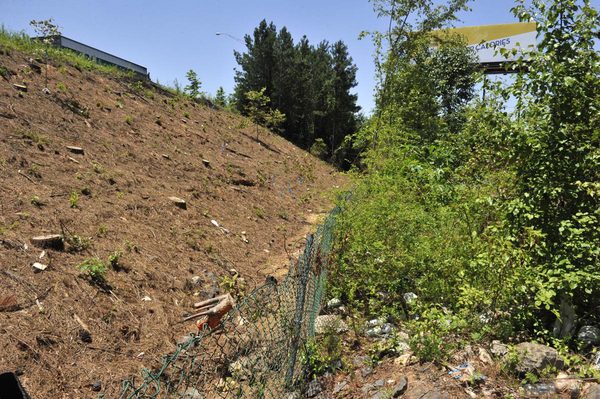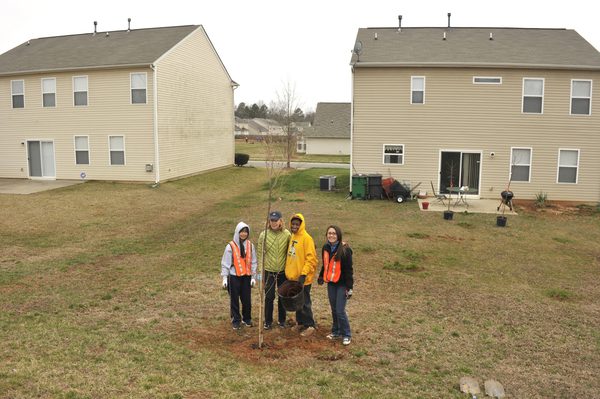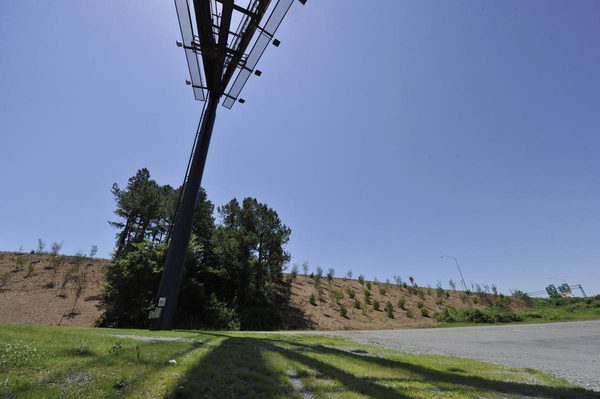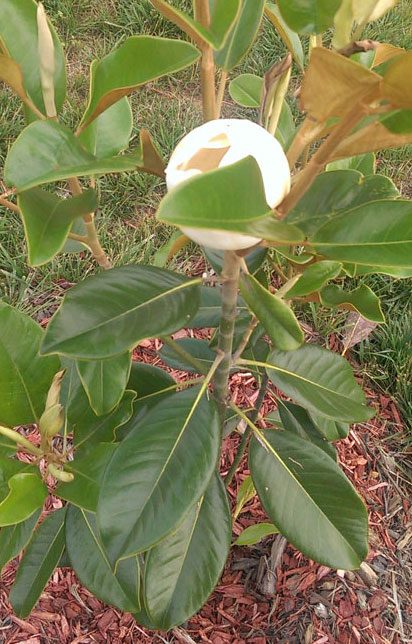For Charlotte trees, is it one step forward, two steps back?

On a blustery March day last year, Syreeta Kitchen-Dukes and her neighbors in the Applegate Community of east Charlotte gathered in rainy front yards to meet the neighborhood’s newest residents: 177 young trees.
| See more tree photos at article’s end. |
The would-be forest arrived with a crew from TreesCharlotte, a public/private collaborative whose goal is to plant trees in neighborhoods that need them. That definitely applied to Applegate, a fairly new development near Mint Hill, says Kitchen-Dukes, president of the Applegate Homeowners Association.
“Unless the homeowners themselves planted trees, no one really had trees in the yard,” she says. “It’s so bare around here.” 
Billboard tree clearings in North Carolina
Senate Bill 183, passed in 2012, lets outdoor advertising firms bypass local ordinances and take tree-clearing requests to the N.C. Department of Transportation. After it took effect in March 2012, requests to cut trees surged.
| Tree-cutting approvals |
March 1, 2011 – March 1, 2012 | March 1, 2012 – March 1, 2013 |
|---|---|---|
| Charlotte | 16 | 103 |
| Region* | 32 | 135 |
| N.C. | 182 | 928 |
* “Region” refers to an N.C. DOT division of Mecklenburg, Anson, Cabarrus, Stanly and Union counties. To learn how many N.C. trees cut, see end of article. (Source: N.C. DOT)
The new maples, oaks, magnolias and other trees taking root there are among scores planted last year in Charlotte, part of a City Council-approved campaign to get 50 percent of the city covered by trees by 2050. Right now, about 46 percent of Charlotte land area is covered in tree canopy, and reaching 50 percent means adding a half-million more trees – and that doesn’t count trees needed to make up for unforeseen clearing.
While experts said today’s tree canopy is healthy, it faces new threats from several sides.
When Dave Cable, head of TreesCharlotte, looks at his group’s private-property planting record, he feels good – until he considers that during the same time his group planted some 4,000 trees, billboard companies were cutting down more than 4,000.
A new state law last year lets billboard companies clear trees from around their signs, even if local ordinances previously barred the practice, as Charlotte’s did. Since the measure passed, the N.C. Department of Transportation has been flooded with requests from billboard companies to clear trees. Statewide, approvals for tree clearing have shot up nearly 410 percent. In Charlotte, some high-profile clear-cuttings along I-77 generated a spate of recent publicity.
It’s not just billboard companies seeking tree-cutting permits. Businesses on state roads also got leave to bypass local ordinances if they want to cut trees blocking the view of their business. Already, four companies in Charlotte have gotten state approval for tree removal.
The new law affects more than just rural highways. It applies on a number of major Charlotte thoroughfares, such as the interstate highways, Independence and Brookshire boulevards and Albemarle Road, but not on every state-maintained road in the city.
Trees also may fall victim to something most people would welcome: an improving economy. Resurgent development is likely to mean more clearing. That means those who are planting trees will need to work even harder.
In newer areas ‘not a tree in sight’
Driving through Charlotte’s oldest neighborhoods, one may not feel the urgency behind the tree canopy campaign. Places like Myers Park, with its stately columns of willow oaks, and older south Charlotte suburbs such as Cotswold and Stonehaven, with their mature hickories, white oaks and shortleaf pines, all seem well shaded. But much of the Charlotte region doesn’t look that way.

“As we go into these neighborhoods – and these are a lot of disenfranchised areas – there’s not a tree in sight,” Cable says. “There are an awful lot of neighborhoods, particularly those developed in the ’80s and ’90s” that are barren of trees.
Trees have value to the environment beyond their beauty. They cool neighborhoods, provide critical habitat for wildlife, dramatically slow storm runoff and can increase home values by more than 20 percent, according to N.C. State University. By the time a tree reaches age 40, it can sequester one ton of carbon dioxide in the atmosphere.
Beyond billboards, development in the region can also affect tree cover. To be sure, some in-fill development, particularly in former industrial areas, such as Charlotte’s South End, can add trees to the canopy. And the city has strengthened its tree ordinance, requiring developers to save more trees than previously.
But much commercial and residential development in the past has substantially cleared land of vegetation. In only five years, from 2003 to 2008, Charlotte lost 3 percent of its tree canopy – an area equal to 10,000 acres of trees.
Then the recession hit, and the trees stopped coming down.
“The preliminary results from last year show we’ve held steady since 2010,” Cable says. “The bleeding stopped, and we’re status quo. It tells me a couple of things: One, development has a dramatic impact on the future of the canopy, and the other is, if we’re going to grow the canopy, we’re going to have to plant a lot of trees.”
Charlotte soon will get a fresh look at just how healthy its tree cover is. Tom Johnson, senior urban forestry specialist with the city, is working with the University of Vermont on a tree canopy report, due out in coming weeks.
Johnson expresses cautious optimism.
“As the economy cranks back up, I think that our tree canopy will fair very well,” he says. Increasing the canopy to 50 percent by 2050 will take more than the tree ordinance, though, he notes. “It will be a concerted effort across many platforms including city and county tree planting, tree protection, and, most importantly, private property tree planting and care.”
Billboard companies ‘playing catch-up’
For its part, Adams Marketing, the main company behind the billboard clearing in Charlotte, wants to emphasize that it is “playing catch-up for the last 10 years” by cutting vegetation around its signs, and has “cleared 80 percent of what we can get a state vegetative removal permit on,” says spokeswoman Karen Price.

Adams “is lawfully working within the regulations established by the State of North Carolina,” says General Manager Kevin Madrzykowski. “These regulations essentially allow us to restore and maintain visibility for our advertisers, and require us to compensate the NCDOT for existing tree removal. Our internal philosophy has been to be selective with our vegetation program, removing only such vegetation that impairs the visibility of our displays and replanting trees where appropriate. Our impact on the overall tree canopy is minimal when compared to tree removal due to development, road widening, utility maintenance, etc.”
Indeed, the city has seen extensive tree clearing along Independence Boulevard and the crossroads it touches, as part of a road-widening project.
The city may see additional businesses coming forward with requests to cut trees, and though it gets to review and make comments on the applications, it no longer holds veto power.
“It frustrates me,” city arborist Don McSween says of the loss of local control. “A lot of these areas that have been cleared are right next to protected streams, and now you have exposure to soil erosion into the creeks.”
Still, McSween is hopeful the city will make the tree canopy more robust in years to come. He points to aerial spraying several years ago to protect aging willow oaks from cankerworm damage and to trees the city planted throughout the year along sidewalks.
Cable says his group is focused on fundraising so it can get to its goal of planting 15,000 trees every year. One source of optimism for both: Everyone, it seems, gets excited about helping trees.
“People really enjoy planting trees,” Cable says. “It’s almost like trees are a rallying point for communities that don’t have a lot of social fabric to hold them together. We get comments like ‘This is the first time our neighborhood ever worked together.’”
Today in the Applegate neighborhood, Kitchen-Dukes is admiring her newly planted magnolia’s first blossom and enjoying a cluster of new ornamental cherry trees in her backyard. Walking through the neighborhood, she sees the new trees filling in. “They’re pretty leafy,” she says. “It’s starting to be more of a home.”
How many trees have been cut?
The N.C. Department of Transportation doesn’t tally the number of trees cleared for billboards. It tracks money received for trees, based on “caliper inches.” It counts only the caliper inches of what are defined as “existing trees,” trees at a certain size when the billboard was installed. Since the new billboard-clearing law, North Carolina has seen 9,050 caliper inches of existing trees removed. (Charlotte’s total in that time has been 5,530.5, more than half the state’s total.) Billboard companies pay the state $75 an inch for such trees, so North Carolina has collected $678,750 for those cut trees, with $414,787.50 of that from Charlotte.
– Source: N.C. DOT
See more photos of Charlotte trees
[view:slideshow2=block_1]